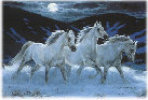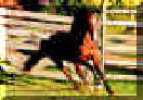Every movement we make sends a message to our horse. Very often, misbehavior on the horse's part is a result of miscommunication on our part. When things are going wrong, try and determine whether some tension in your body or misplaced weight is creating the reaction in your horse. More often than not, this is the case. Take a deep breath, let it out and try again. Relax and savor the joys of riding.
Your balance on the horse is the same as it is on the ground. Your shoulders, hips and heels should be in alignment. As easy way to check your balance when mounted is to stand straight up in the stirrups without holding on to your horse for balance. If your leg is ahead of you, you will fall back into the saddle. If it is behind you, you will fall forward. Move your leg around until it is easy to stand up without supporting yourself with your hands. Try this at the walk and trot once you can do it standing still.
To affect your horse's balance, you must place your weight where you want the horse to carry you. Think about what happens when you pick up a heavy bag - you move your hip underneath the bag to support it so that you don't fall over. The horse does the same thing with you. When your weight falls forward or backward, or to the inside or outside, your horse moves underneath you to support that weight. To try and feel where your weight is placed, walk you horse on a circle. Sit up straight, and drop your inside stirrup. Feel how that pulls your weight down to that side of the horse. Pick up stirrup and then drop the outside stirrup while still walking on the circle. Your weight will fall to the outside, and you will notice that your horse has a harder time staying on the circle.
Too often, riders confuse going forward with going faster. Slow down! It is much more difficult for the horse to lift up his back and listen to your signals when he is hurrying. To help establish a good tempo, think of a favorite song or nursery rhyme (such as one-two-buckle-my-shoe, etc.). Pick one that is easy to remember and has a nice slow rhythm to it. Recite it out loud when you are trotting, cantering or approaching a fence - anytime you feel like your horse is hurrying away from you. Your brain wants to synchronize the movement of your body to the tempo of your voice. As your body movement slows down, your horse will slow down as well.
Do you get ahead of your horse over fences? Most times, that is an indication that you are not using your lower leg as a base of support. When jumping a fence, you should be bending at the hip joint, not at the waist, keeping your knee bent. This will keep your body in alignment, and help maintain your balance while jumping the fence. One way to help feel this is to set up a small fence (vertical or x-rail) near the rail of the arena if possible. As you approach the fence, go into your jumping position and put the reins in your outside hand and hold your inside hand straight out away from your body. Don't let your hands touch the horse's neck as you jump the fence. This will force you to balance off your leg - if you bend at the waist, rather than at the hip, you will fall forward onto your horse's neck.







woodcrst@bellsouth.net





